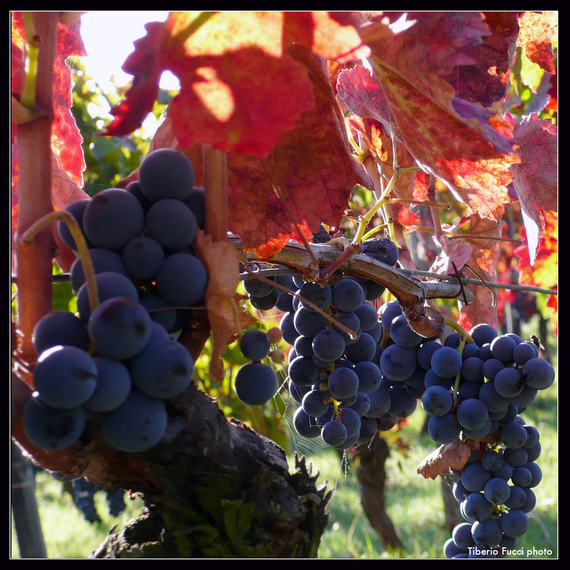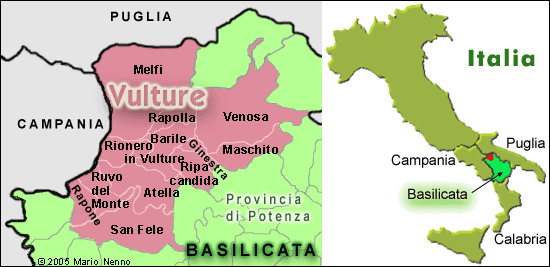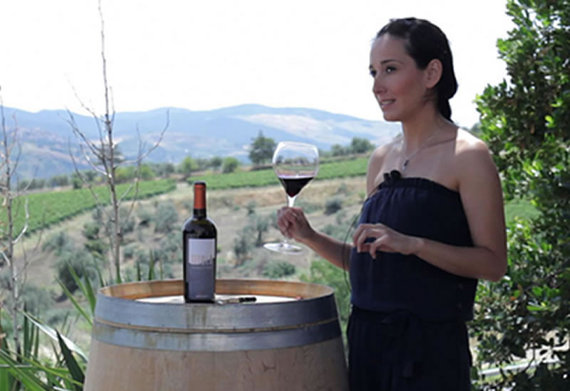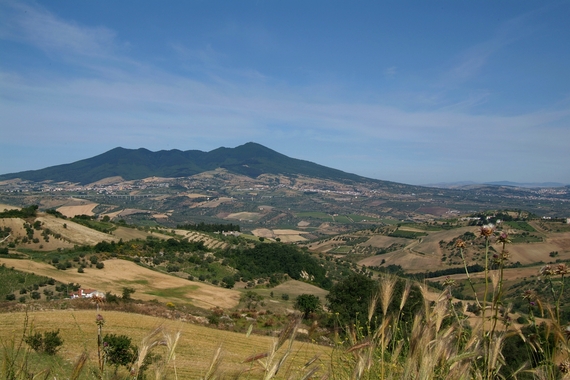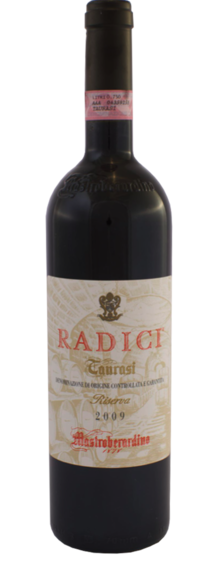Ripe Aglianico grapes in the vineyard. Picture courtesy Elena Fucci
According to the Wine Economics Research Centre at the University of Adelaide, the wine industry produced over 7.7 billion gallons of wine in 2014. That's enough for a little over a gallon of wine for every single person on earth. Remarkably, although there are over a thousand grape varieties suitable for making wine, two-dozen varieties accounted for roughly 85 percent of the world's wine production.
Italy is a welcome exception to the increasing uniformity of the wine world. There may be over 2,000 varieties of wine grapes currently cultivated in Italy - no one is really sure. At least 350 specific varieties have been identified and studied to varying degrees. Many of these unique wines never make it far from their immediate environs. Those that do make it to North America are often lost in the veritable sea of Cabernets and Chardonnays that crowd the typical wine store.
Among Italy's most remarkable wine offerings is a little known grape called Aglianico (pronounced ah-l'yee-an-nee-koh). This is an ancient grape whose origins are still buried in the recesses of antiquity. First cultivated in Greece, it was brought by Greek settlers to ancient Cumae in southern Italy around 800 BC. Its name is likely a corruption of the Latin term Vitis hellenica or "Greek vine." Until the 15th century it was referred to as Ellenico - the local term for Greek.
Aglianico was possibly the principal grape variety in the Roman world's most expensive wine, Falernian. The Roman author and naturalist Pliny the Elder described wines made from Aglianico as among the greatest in antiquity. Dennis Dubourdieu, a Bordeaux winemaker and a professor of oenology at the University of Bordeaux, has described Aglianico as "probably the grape with the longest consumer history of all."
Aglianico di Vultura zone in the province of Potenza, Basilicata, Italy Map courtesy Mario Nenno
The grape buds early and is late ripening. It thrives in hot, dry climates. Today, it is cultivated in such disparate places as the Murray Darling region of Australia, as well as Texas, Arizona and California. Remarkably, the grape is also grown at Vieni Estates in the rolling hills of the Vinemount Ridge of the Niagara Peninsula in Ontario. It is in southern Italy, however, in the regions of Basilicata and Campania, that the grape reaches its apex.
In Basilicata, Aglianico has the distinction of being the region's only DOCG wine (Denominazione di Origine Controllata e Garantita), Italy's highest wine classification. The Aglianico di Vultura, produced on the steep slopes of Mt. Vulture, an ancient volcano in the northern area of the province of Potenza, is widely considered to be one of southern Italy's greatest wines.
The free draining, rich, dark soils of decomposed volcanics, combined with the higher altitude, allow the Mt. Vulture zone to produce particularly rich, concentrated wines. The best performing sites are between 1,000 and 1,600 feet. The temperatures are slightly cooler there, with a notable diurnal swing in temperatures. The altitude helps to preserve acidity, while at the same time slowing the accumulation of sugars, prolonging the ripening or "hang time" of the grapes. This area is among the sunniest in Italy. Vineyards here receive more hours of sunshine than just about any other grapes in the world.
Elena Fucci with a bottle of her signature wine, Titolo
Picture courtesy Elena Fucci
One of the most highly rated Aglianico del Vulture wines, is the Elena Fucci, Titolo.
This wine is produced from vineyards over 1,800 feet above sea level, among the highest in Vulture. This is a powerful wine with a complex nose offering aromas of ripe, almost jammy, black fruit, followed by dried herbal notes of fragrant rosemary, as well as tobacco and wood spice. There are traces of cinnamon and slight hints of vanilla, underscored by smoke and a crushed stone minerality.
On the palate the wine is dry. It's full-bodied with a notable weight and plenty of ripe black fruit. It's nicely balanced with fine and firm tannins, neatly contrasted to the fruit, and underscored by a notable acidity. The finish is long, with a complex array of ripe dark fruits and dried Mediterranean herbs. This review is for the 2012 wine, a slightly warmer than average year in southern Italy, but is indicative of the Fucci style of Aglianico offerings.
Monte Vulture an extinct volcano famous for the quality of the wine from its Aglianico vineyards
The only other DOCG designated production zones for Aglianico are in and around the villages of Taurasi and Taburno in Campania . Today there are over 300 producers of Aglianico in Campania, but only a handful export their wines to the United States. Here too, the best wines are produced at higher altitudes, typically 1,000 to 1,500 feet above sea level. Unlike Mt. Vulture, the soils here are mostly layers of marls and limestones broken up with sand and clays from decomposed volcanics.
Mastroberardino's Radici Taurasi
In Campania, Aglianico has long been associated with the Mastroberardino family. The late Antonio Mastroberardino is widely given credit for identifying and preserving many of the ancient grape varieties of the region, and in particular Aglianico. Until the resurgence of the grape variety, the Mastroberardino family was responsible for 90 percent of the Aglianico produced in Campania. The powerful tannins and classic aromas of tar and earth that characterize these wines have led them to be called the "Barolo's of the South."
The Mastroberardino Radici Taurasi is made from 100 percent Aglianico grapes. With bottle aging, this is a smooth, rich, silky wine with fine, well-integrated, tannins. This is a dense wine with notable mouth feel and texture, but still balanced. On the nose, it exhibits the dry, herbal, aromatic notes of the Mediterranean's wild mountain brush and the dense concentrated fruit that is the signature trademark of Aglianico.
On the palate there are distinctive notes of smoked, dried meat and intense tropical spice, featuring cloves and a hint of cinnamon, as well as concentrated fruit. The finish is long and complex, with a mixture of dried aromatic herbal notes and dried meat and mushroom flavors against a backdrop of dried, at times jammy, black fruit. This review is for the 2009 wine, but it is indicative of the Mastroberardino style.
The classic Aglianico style is a deep garnet color with notable intensity and weight. These are full-bodied wines whose powerful tannins, high acidity and concentration of fruit endow them with significant aging potential. Highly tannic in their youth, the wines typically need three to five years of bottle aging before they are drinkable. Its attractive price has earned it the nickname of "the poor man's Barolo."
Aglianico is one of Italy's hidden gems. Little known in North America, it represents an incredible value for one of Italy's finest and historic red wines.
